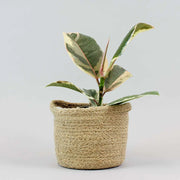Rubber Plant
Rubber Plant
Rubber Plant 'Belize' Pink
Their leaves come in a variety of colour schemes.
The waxy coating of their leaves serves as a fantastic catcher for unwanted particles in the air, purifying and cleaning the air as they go. They have been linked with improving sleep quality for this reason.
They tend to be relatively small and compact so they work in a variety of different spaces. Elevate any room in your home with one of our amazing Rubber Trees.
The waxy coating of their leaves serves as a fantastic catcher for unwanted particles in the air, purifying and cleaning the air as they go. They have been linked with improving sleep quality for this reason.
They tend to be relatively small and compact so they work in a variety of different spaces. Elevate any room in your home with one of our amazing Rubber Trees.
Rubber Plant Names
Also known as rubber plant tree, rubber fig, rubber bush, rubber tree, Indian rubber bush, or Indian rubber tree. The ficus elastica, aka your rubber plant!
Rubber Plant Uses
Rubber plants are called rubber plants for a reason! A sap can ooze from its stems and leaves when cut - no matter if it’s a small or big rubber plant. The sap is present in all parts of the plant! This sap is actually milky in consistency and has a white colour.
The sap of the rubber plant was previously used to make commercial latex. But after some economical studies, it was found that there were other better options. So, the rubber plant can fulfil a different purpose - an ornamental one!
Since the ornamental rubber tree plant produces a milky sap, it’s worth mentioning that it is not safe for pets and children to come into contact with. It is toxic when ingested. The same sap can cause skin irritations, too! So, while the rubber tree plant is a beautiful addition to your home, one should be careful of the potential hazards it might bring.
Another reason why the indoor rubber plant is popular is for its air-purifying qualities. This plant not only produces much-needed oxygen but may also eliminate air toxins. The rubber plant may also help with removing mould spores and bacteria from the air. Neat, huh?
Different Types of Rubber Plants at Bloombox Club
The rubber plant is classified under the Moraceae plant family, which has more than 1100 species. There are indoor rubber plant varieties, however, and we have them here at Bloombox Club!
Let’s go over some of the most common and popular rubber plants for sale, shall we?
Rubber Plant Tineke l Ficus elastica ‘Tineke'
Considered one of the more beginner-friendly small rubber plants, the ficus elastica ‘Tineke’ is very popular. Rubber plant care is super easy for this beauty. It has beautiful glossy leaves that come with a soft pink hue or white accent. You can actually grab one by clicking here!
Rubber Plant Cloe l Ficus elastica 'Cloe'
The Ficus elastica 'Cloe' can grow to be a tall rubber plant when in its natural habitat. As an indoor rubber plant, its growth can easily be managed. What makes this so popular is its large, olive-green, paddle-shaped leaves. Get your very own Rubber Plant Cloe now.
Rubber Plant Belize l Ficus elastica 'Belize'
This is one fast-growing and tall rubber plant in the right condition. It can reach 1.5 metres in height! The ficus elastica 'Belize' is also a rare rubber plant in the UK. You might want to pick one up for yourself!
Rubber Tree Abidjan l Ficus elastica 'Abidjan'
Rounding up our list of popular rubber tree plants is the Rubber Tree Abidjan. This rubber plant makes indoors look fab with its signature burgundy leaves. That’s why it’s called Rubber Tree ‘Burgundy’ at times!
How To Care for Rubber Plants
Indoor rubber plants are quite easy to care for, but that shouldn’t mean that they can be neglected! Rubber plants need to be situated at a proper spot in the house, preferably one without any direct sunlight. Rubber plants with green leaves could live with a little indirect light while the reddish ones need more indirect light to thrive.
As for watering, make sure not to overwater your indoor rubber plants. Once you see that the top soil is dry, that’s when they could use a little drink. Also, if you’re using a drip tray, make sure to clear any excess water out to avoid soggy roots.
With a range from small rubber plants to big rubber plants out there, some repotting might be needed - especially when you want your rubber plants to really grow tall. If that’s the case, then you might want to consider repotting every one or two years.
As for fertiliser, you could give some to your rubber plants during the spring or summer seasons. When it’s winter, skip the fertiliser.
All these being said, this list of how to care for a rubber plant is a generalisation. Some rubber plants might be more finicky than others!
What are the Benefits of Rubber Plants
There are two main benefits that caring for rubber plants could bring. First and foremost, it’s a beautiful indoor plant. You can get small rubber plants, tall rubber plants, or big rubber plants to match your home decor. You can find loads of rubber plants for sale and they’re most likely easy to care for!
You can find ornamental rubber plants in different shades of green, some with white-ish hues, some with pinkish tones, and some with reddish colours. They’ll add a pop of colour when you need them to, and quite effectively!
Second, and probably one often overlooked, is that rubber plants are excellent air-purifying plants. We already know that plants convert carbon dioxide to oxygen. That’s all good, but rubber plants take it a step further. They can rid your air of mould spores and bacteria.
One such study, called the NASA Clean Air Study, actually looked into what toxins plants actually help remove. Rubber plants were shown to be effective at removing formaldehyde. Formaldehyde is a common irritant that’s found indoors. It is said to affect the eyes, nose, throat, and lungs. Even at low concentrations, it may even trigger asthma attacks.
Frequently Asked Questions
Where should I put my rubber plant to help it grow faster?
As long as you meet the needs of your plant (water, light, and maybe some fertiliser), it really shouldn’t matter where your rubber plants are kept! But, if we were to give out some more specifics, maybe a spot near a window would be ideal - but remember, no direct sunlight! You don’t want to burn your rubber tree plant’s leaves!
Does the rubber plant need direct sunlight?
Glad you asked! Generally, rubber plants do not like it when they are put in places where there is bright, direct sunlight. In most cases, bright and indirect sunlight works wonders for indoor rubber plants.
They do like it warm, though. Just avoid cold drafts and keep them in rooms that have warm to average temperatures then you should be fine.
Can I put my rubber plant in the bathroom?
You could! Just remember to keep away from direct sunlight (we can’t stress this enough). The rubber plant hails from jungle-y and tropical climates. As long as your bathroom meets that temperature, your rubber plant should be ok.
Keep away from cold drafts. You might find that the leaves of your rubber plants deteriorate when kept in the cold. This damage might be irreversible, meaning that they won’t regrow!
Can I have a rubber plant if I have pets in the house?
Realistically, you could keep rubber plants inside your home as long as you keep a watchful eye on your furry friends. Reflecting what we mentioned earlier, all parts of rubber plants produce a sap that can be toxic to cats and dogs. They could also cause skin irritations.
As long as you can train your pets to keep away and not paw at your plants (as you actually should), you can actually keep indoor rubber plants!
How often should I water my rubber plants?
As often as needed. We’ll get into that. Generally, rubber plants hate being soaked in water. So, keep them in well-draining soil. As soon as you see the top soil gets a little dry, then you can water your rubber plants. If you notice your rubber tree plant’s leaves get a little droopy, then that means it needs more water than you’re giving it.
It takes a while to get acclimated to the watering schedule of your rubber plants. Once you do, stick to it!


















